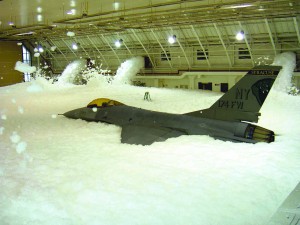Aircraft Hangar Fire Protection
Today’s commercial and military aircraft are extremely expensive pieces of equipment. From a fire protection standpoint, the aircraft hangars where these high-value airplanes are stored are unique facilities for several reasons. There typically will be a significant amount of flammable liquid aircraft fuel present. The regularly occurring maintenance activities provide several potential ignition sources. Also, the airplanes themselves have large main bodies and wings, which create sizeable obstructions for many typical fire protection systems.
Although NFPA 409 “Standard on Aircraft Hangars” is the most common standard for the protection of aircraft hangars, the U.S. Air Force ETL 02-15 is applicable to Air Force and Army facilities, whereas the UFC 4-211-01N addresses Navy and Marine Corps facilities. Insurance company requirements may also govern on a particular project. For the purpose of this article, we will discuss NFPA 409 requirements. Most other standards follow the general format and content of NFPA 409, but often have slightly differing criteria.
When choosing a fire protection system for an aircraft hangar, the classification of the hangar must first be determined. There are four types of aircraft hangar groups which are classified as follows, per NFPA 409:
Group I aircraft hangars shall have at least one of the following features and operating conditions:
- An aircraft access door height over 28 ft (8.5m)
- A single fire area in excess of 40,000 ft2 (3716 m2)
- Provision for housing an aircraft with a tail height over 28 ft (8.5m)
Group II aircraft hangars shall have both of the following features:
- An aircraft access door height of 28 ft (8.5m) or less
- A single fire area of 40,000 ft2 (3716 m2) or less, and in accordance with Table 4.1.2 in NFPA 409 based on the type of construction and single fire area.
Group III aircraft hangars may be either a row hangar with multiple units or an open bay hanger capable of housing multiple aircraft or a freestanding unit for a single aircraft. Group III hangars shall have both of the following features:
- An aircraft access door height of 28 ft (8.5m) or less
- A single fire area of 30,000 ft2 (3716 m2) or less, and in accordance with the maximum single fire areas for each construction type as shown in NFPA 409, Table 4.1.3.
Group IV aircraft hangars shall be a structure constructed of a membrane-covered rigid steel frame.
Once the aircraft hangar classification group is determined, an appropriate fire protection system must be chosen. Generally speaking, the fire protection options for fueled aircraft hangars’ service and storage areas for Group I and II hangars are the following:
- Foam-water deluge system, with supplementary protection systems under single aircraft wing areas over 3000 ft2 (279 m2). The supplementary protection systems will be a low-level low-expansion foam system using oscillating monitors or a low-level high-expansion foam system.
- A combination of automatic sprinkler protection and an automatic low-level low-expansion foam system.
- A combination of automatic sprinkler protection and an automatic low-level high-expansion foam system.
- For Group II hangers, a closed-head, foam-water sprinkler system is also an option.
When opting for a combination of automatic sprinkler protection and foam, automatic sprinkler systems for Group I hangars are to be designed for 0.17 gpm/ft2 over 15,000 ft2, whereas Group II hangars will utilize the same design density over 5,000 ft2.
For Group III hangars, fixed fire protection systems are not normally required, but ensure to check your locally adopted building codes. If there are hazardous operations such as fuel transfer, welding, torch cutting, spray painting, etc. performed in a Group III hangar, the hangar would need to meet the fire protection requirements of a Group II aircraft hangar.
For Group IV hangars with fueled aircraft, fire protection options for storage and service areas are either:
- A low-expansion foam system, or
- A high-expansion foam system
For Groups I, II and IV hangars housing unfueled aircraft only, a wet pipe or single-interlock pre-action system may be employed. The automatic sprinkler system must be designed to provide 0.17 gpm/ft2 over the hydraulically most demanding 5,000 ft2.
There are many other potential requirements for aircraft hangar fire protection systems including, but not limited to:
- Fire water storage tanks and fire pumps
- Foam and/or water hand hose lines
- Foam concentrate tanks and pumps
- Trench drain systems for hangar floors
- Structural steel column protection
Detailed fire protection system requirements are found in the NFPA 409 standard.
Aircraft hangar fire protection systems have numerous and often times complex code requirements. The wide array of design choices and installation requirements must be carefully weighed to find the most cost-effective and code compliant system to protect

your high-value aircraft. American Fire Protection Group has the qualified professionals and the proven experience to handle your aircraft hangar fire protection design, installation, and service needs. If you would like to learn more about aircraft hangar fire protection, contact one of our team members today!